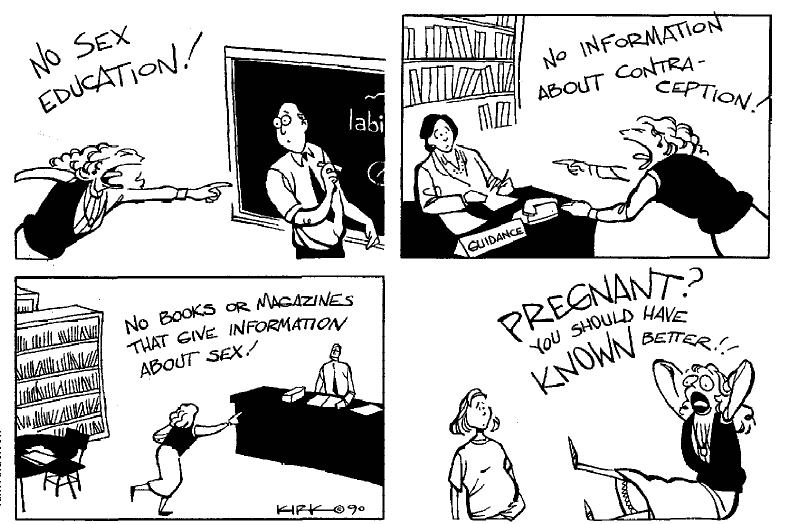Preaching Ain’t Teaching
Sex Education and America’s New Puritans

Organizations within the “religious right” frequently attack comprehensive sex education, arguing that the only acceptable approach is to teach “abstinence only.”
New York City, for example, had been in the lead in efforts to combat the problem of HIV/AIDS among adolescents, including a high school condom availability program instituted in 1991. But last year, the New York City Board of Education took a step backward. A conservative majority, with support from the then newly appointed School Chancellor Rudy Crew, adopted a high school curriculum that requires health education teachers to continually stress that teenagers should not engage in sexual intercourse. The board also prohibited classroom demonstrations of condom use as a protection against HIV/AIDS infection and unwanted pregnancies.
Concerned educators, parents, teenagers, and health professionals must convince the public at large that it is futile to try and reach today’s youth by focusing on “abstinence only” initiatives.
It makes sense to help teenagers postpone sexual relationships that they are not emotionally prepared to handle. But this can only happen when adults speak with teenagers openly and honestly about options and allow them to express their concerns about their sexuality and hopes for the future. It won’t happen when politicians instruct teachers to preach to students.
Even a cursory glance at U.S. history demonstrates that “preaching ain’t teaching.” A good example is the experience of Puritan ministers in colonial Massachusetts. Over 250 years ago, Jonathan Edwards delivered a series of powerful sermons to his congregation in Boston. Reverend Edwards was deeply troubled by what he saw as increasingly sinful behavior in the city. In one of his most noted sermons, Edwards warned the people of New England that if they did not change their wicked ways, they would be destroyed by God’s “inconceivable fury.” Curiously, this sermon did not mark the high point of Puritan influence in colonial Massachusetts, but its eclipse.
Edwards and his brethren found themselves preaching in harsher and harsher language against what they conceived of as a rising tide of immorality. They threatened ever greater devastation because their warnings were being ignored by the general population.
LIFE HAD CHANGED
Life and culture in New England had changed and the Puritan ministers could not adjust. According to the article “Urban Wealth and Poverty in Pre-Revolutionary America (1976)” by historian Gary Nash, trade and commerce had become more important in New England than religious piety. The population was increasingly diverse and new people meant new ideas and values. In addition, economic problems contributed to troubling demographic trends. Large numbers of single young men and women were leaving crowded farms and migrating into the towns. As a result of economic dislocation from 1700 to 1750, expenditures for poverty relief in Boston increased twice as fast as population growth. Another change was a sharp rise in the average age at which women married. Changes in sexual mores accompanied the economic and demographic shifts.
Research by James Henretta for his book The Evolution of American Society, 1700-1815: An Interdisciplinary Approach (1973) shows that in the 1660s, premarital conceptions in a typical New England town were under 10%. However, by the 1750s, premarital conceptions accounted for between 30% and 50% of the pregnancies in some communities. As hard as they tried to teach “sinners” to change their sexual practices, Puritan ministers went unheard because their warnings did not address conditions in people’s lives.
The New York City Board of Education’s decision to limit the HIV/AIDS and sex education provided to sexually active teenagers is another doomed effort to preach morality. The new policy ignores the cultural and demographic changes taking place in American society. In addition, it is highly irresponsible in that it increases the likelihood that uneducated teenagers will engage in unprotected sex.
In 1991, unmarried women in the U. S. had a record 1.2 million births. The non-marital birth rate, which has doubled since 1980, is even higher for young women ages 18 and 19. The birth rate for teenagers has social, educational, and medical implications. Teens give birth to a high percentage of low birth weight babies; young mothers are 50% less likely to complete high school; and daughters of teenage mothers are more likely to become teenage mothers themselves.
Unprotected sex also means an increased risk of infection with the deadly virus that causes HIV/AIDS. The urban, minority youth who make up approximately 80% of New York City’s public-school population have the highest rates of infection.
However, federally financed research studies, including ones conducted in New York public schools, demonstrate that comprehensive AIDS education classes that include instruction in condom use can delay the age when young men become sexually active and alter their attitudes towards risky sexual practices.
Opponents of including instruction in condom use in comprehensive HIV/AIDS and sex education programs argue that they give teenagers a false sense of security because condoms can fail. They claim that abstinence is the only fool-proof way of preventing pregnancy and the spread of sexually transmitted diseases.
The reality is very different. When latex condoms are used correctly, they are 98-100% effective in preventing pregnancy. In addition, laboratory tests show that they completely block transmission of the HIV/AIDS virus. When condoms do fail, it is overwhelmingly because people do not use them properly.
Abstinence from sexual intercourse as a protection against pregnancy and disease must also be correctly and consistently practiced to be effective. In this country, 80% of the population reports having had sexual intercourse as a teenager. Despite initial intentions, people often fail to abstain from sex. As a result, 26% of the women who report abstinence as their regular method of birth control become pregnant each year.
One of the ironies is that society sends mixed messages to youth. On the one hand, young people enter puberty engulfed in world of advertising images in which sex is used to sell consumer products. On the other hand, restrictions on sexual education mean that educators and health professionals are prevented from adequately preparing teenagers to act responsibly and safely when it comes to sex.
America’s new Puritans need to learn a history lesson about the impotence of preaching their version of sexual morality to young people. If they can’t learn from Jonathan Edwards, then educators, parents, teenagers, and health professionals have to prevent them from gaining control over our educational institutions. The future of our young people is at stake.

